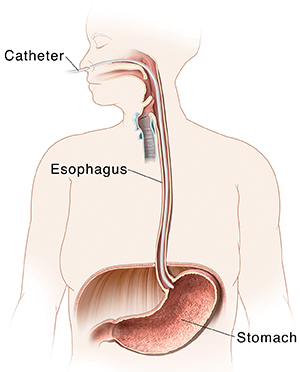Esophageal Manometry
Esophageal manometry is a test to measure the strength and function of the esophagus (the “food pipe”). Results can help identify causes of heartburn, swallowing problems, or chest pain. The test can also help plan surgery and determine the success of previous surgery.
 |
| A catheter measures pressure along the esophagus. |
Preparing for the test
Be sure to talk to your healthcare provider about any medicines you take. Some medicines can affect the test results. Also, ask any questions you have about the risks of the test. These include irritation to the nose and throat. Do not smoke, eat, or drink for up to 12 hours before the test.
During the test
Manometry takes between 10-30 minutes. Usually you lie down during the test. Your nose and throat are numbed. A soft, thin tube is then placed through the nose and down the esophagus. At first, you may feel some throat discomfort which should improve quickly. You will be asked to swallow several times. Sensors along the tube measure the pressure while you swallow. Measurements are analyzed based on the pressures of the muscle contractions and relaxations in your esophagus.
After esophageal manometry
You may receive preliminary results right after the test is done. An appointment may be scheduled for you to discuss the results. This is because time is needed to review the study. You may have a mild sore throat for a short time. As soon as the numbness in your throat is gone, you can return to eating and your normal activities.